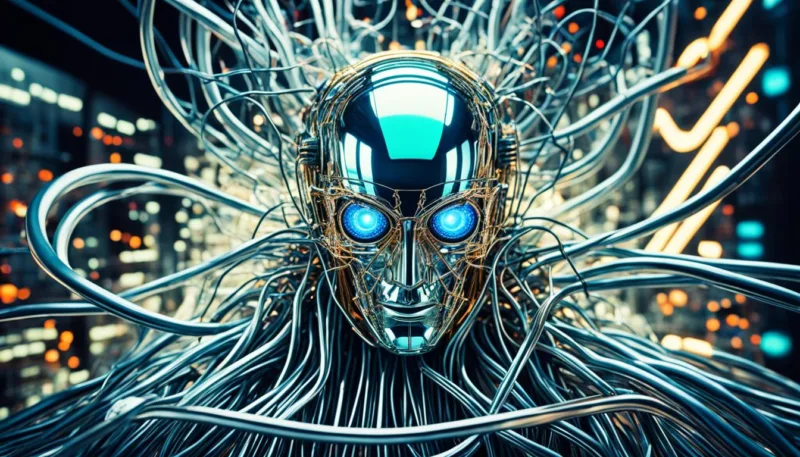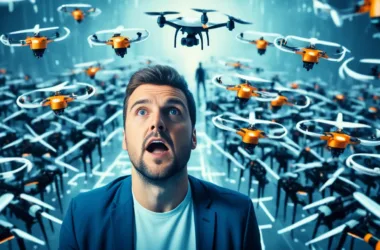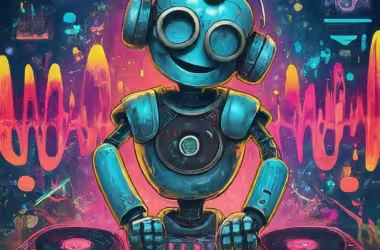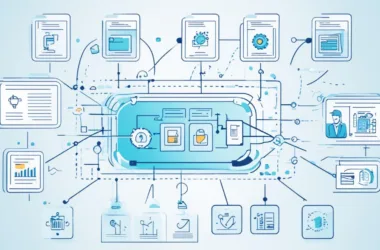The history of AI is both fascinating and goes back a long time. It starts with the dream of making machines that think like us. This dream was first imagined in ancient myths and has grown over centuries.
By the time the 20th century came around, things really started to heat up. Alan Turing put forward the idea of the Turing Test. This was a way to see if machines could truly think. At the Dartmouth Conference, John McCarthy gave AI its name.
The second half of the 20th century was a roller coaster for AI, with ups and downs in interest. But then, something big happened. Machine learning and neural networks brought AI back into the spotlight. Now, AI is a huge part of our daily lives. It’s changing how we do everything from work to having fun.
Key Takeaways
- Artificial intelligence evolution spans from ancient automata to modern computing machinery.
- AI history includes pivotal moments such as the Turing Test and the Dartmouth Conference.
- Alan Turing and John McCarthy are seminal figures in AI’s development.
- Machine learning and neural networks sparked a modern renaissance in AI.
- AI technologies now permeate various aspects of daily life, from healthcare to entertainment.
Ancient Origins: Mythical Automatons and Early Concepts
Since ancient times, people have been fascinated by the idea of creating life-like machines. This curiosity began with stories from old cultures, especially in Greek myths.
Mythical Automatons in Ancient Greece
Greek myths often speak of automata, with Talos as a famous example. This giant bronze guardian protected Crete. Created by Hephaestus, the god of fire, Talos had intelligence and could move like a human. This story shows early humans dreaming of creating automated beings.
The Seeds of Artificial Intelligence in Early History
The ancient myths did more than entertain. They laid the early groundwork for what would become AI research. The story of Talos, for example, shows early ideas of machines acting like humans. These stories showed a deep wish to make inanimate objects come to life. They hinted at future scientific goals.
Ancient societies used these stories to express a longing to connect humans and machines. They planted the ideas that would grow into artificial intelligence research. This dream has been part of humanity for centuries.
The Birth of Modern Artificial Intelligence
Modern AI began when it moved from just ideas to serious study. This shift happened thanks to thinkers like Alan Turing and John McCarthy. They built the key ideas for AI.
Alan Turing’s Vision and the Turing Test
Alan Turing is called the father of computer science. He saw a future where machines think like us. In 1950, he introduced the Turing Test. It checks if machines can think like humans.
The Turing Test started a new era for AI. It challenged people to make smarter machines.
The Dartmouth Conference and John McCarthy’s Contribution
In 1956, John McCarthy set up the Dartmouth Conference. This meeting is seen as AI’s starting point. McCarthy named it “artificial intelligence.” He dreamed of machines that could do human tasks.
This meeting sparked a lot of AI research and breakthroughs. McCarthy’s work made a huge mark on AI.
Optimism and Early Challenges
The beginning of symbolic AI was filled with hope. Researchers were excited about making problem-solving machines. They wanted to create machines that think like humans, covering many smart tasks.
Arthur Samuel and his checker-playing software were among the first tries. Then came Newell and Simon with their Logic Theorist. This was a big step for machines learning to think like us.
But, this journey wasn’t easy. Symbolic AI faced big problems early on. Machines couldn’t yet match human thinking due to limited computer power and understanding. This made everyone think harder about how to make AI better.
The AI Winter: A Period of Disillusionment
In the late 1970s and early 1980s, excitement about artificial intelligence started to fade. This period is now known as the AI Winter. The high hopes led to a lot of investments and big expectations. But, many projects did not achieve their ambitious goals, causing disappointment.
During the AI Winter, the dream of machines thinking like humans was not reached. The lack of powerful computers, limited understanding of human thought, and too optimistic timelines made things tough. Funding for AI research dropped as both governments and private companies cut back, slowing down progress.
This tough time made the AI community think over their plans and hopes. Reevaluating how to build smart machines, researchers set the stage for future breakthroughs. The hard lessons from this time of reduced AI funding led to a more careful and planned approach in AI studies. This approach helped the field to eventually bounce back stronger.
The Renaissance of AI: Machine Learning and Neural Networks
The late 20th century was a turning point for AI. It moved from rule-based systems to machine learning. This shift was possible thanks to better computers and smarter algorithms. Now, AI can learn from data instead of just following set rules.
From Rule-Based Systems to Data-Driven Models
Originally, AI systems depended on strict rules for every decision. This method had its limits, though. With data-driven AI, things changed dramatically. Now, AI uses huge data sets to find patterns and make choices on its own. This new way has made AI much more powerful and versatile.
The Resurgence of Neural Networks in the 21st Century
In the 21st century, neural network advancements have made a strong comeback. They’ve transformed areas like recognizing images, processing speech, and understanding languages. Thanks to neural networks, AI now excels at learning from raw data. This has led to some amazing breakthroughs, embedding AI deeply into today’s tech.
The Modern Era: AI Integration into Everyday Life
AI is changing how we use technology every day. It makes our lives easier and more efficient because of deep learning. Now, smart technologies help us do less work but achieve more.
Virtual Assistants and Smart Technologies
Virtual assistants like Amazon’s Alexa and Apple’s Siri show AI’s big role in our lives. They let us do tasks, control our homes, and get info just by talking. They get better at understanding us as time goes on.
AI in Healthcare, Transportation, and Entertainment
In healthcare, AI is a game-changer. Tools like IBM’s Watson can diagnose faster and more accurately. This could mean better health for everyone.
Self-driving cars by Tesla are making roads safer and trips more efficient. Meanwhile, AI in entertainment means Netflix and Spotify know exactly what you’ll like next. It makes watching or listening more fun.
By blending into our daily lives, AI is making big changes in many areas. It proves that AI is very important in our world today.
The History of AI: Key Figures and Milestones
In the world of artificial intelligence, some AI key figures are legendary. Alan Turing, known as the father of computer science, tops this list. His invention of the Turing Machine introduced the idea of machines doing logical tasks. This idea led to the Turing Test. It’s a test to see if a machine can act as smart as a human.
John McCarthy is another key player. He came up with the term “artificial intelligence” at the Dartmouth Conference in 1956. This event marked AI as its own field of study. McCarthy also made the LISP programming language. It’s key for AI research and is still important today. His work helped shape the field of AI as we know it.
The early work of Alan Turing and John McCarthy paved the way for AI’s growth. Their groundbreaking work had a huge impact. It not only directed the early days of AI but also encourages today’s researchers and developers.
Deep Learning and the Advancement of Large Language Models
Deep learning has dramatically changed artificial intelligence. It lets machines solve hard problems with amazing precision. Deep learning shows its power in tasks once thought only humans could do.
By using smart algorithms and big datasets, deep learning models outperform humans in some areas. This progress is clear in various complex tasks.
Transformative Impact of Deep Learning
Deep learning’s impact is huge across many areas. It shines in things like image recognition, understanding language, and self-driving technology. These models find complex patterns in big data. This lets them solve problems in new ways.
This shift has expanded AI’s use in science and business. It has become a key tool for breakthroughs and innovations.
Large Language Models like GPT-4
Large language models, such as GPT-4, stand out in AI advancements. GPT-4, made by OpenAI, improves how machines understand and create language. It leads in natural language tasks.
Models like GPT-4 can talk smartly, write articles, and help with in-depth research. They show the big steps deep learning has made in AI’s growth.
FAQ
What is the history of artificial intelligence?
What are some examples of mythical automatons in ancient Greece?
Who were some early pioneers in the field of AI?
What was the Dartmouth Conference?
What challenges did early AI researchers face?
What is the ‘AI Winter’?
How have machine learning and neural networks revived AI?
What role do virtual assistants and smart technologies play in modern AI?
How is AI used in healthcare and transportation?
Who are the key figures in the history of AI?
What advancements have been made in deep learning?
Source Links
- https://medium.com/@Cren.AI/the-journey-of-artificial-intelligence-from-dreams-to-reality-8d181ceb82c2
- https://open.ocolearnok.org/aibusinessapplications/chapter/chapter-2-historical-context-and-evolution-of-ai-ml-a-journey-through-time/
- https://www.goodreads.com/book/show/156613690-a-brief-history-of-artificial-intelligence






